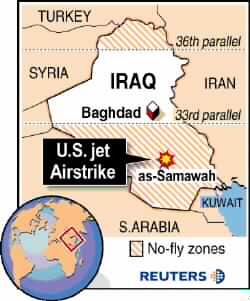WASHINGTON (AP) - U.S. fighter jets bombed Iraqi air defenses in separate attacks Tuesday in the southern and northern ``no-fly'' zones, defense officials said.(Read map caption below)The official Iraqi news agency said the strike in the south injured four people. The Pentagon generally does not comment immediately on casualties related to patrols over Iraq.
Douglas Feith, undersecretary of defense for policy, told reporters that the latest attacks were a continuation of the administration's policy of responding to provocations from Iraqi air defenses.
``We're not going to just absorb passively these challenges to crews who are enforcing a U.N. policy. They're performing an important function, and the Iraqi government has no right to be shooting at them,'' Feith said.
He would not say whether the Bush administration was taking a new, more aggressive approach toward Iraq and its president, Saddam Hussein.
A defense official, speaking on condition of anonymity, said the targets were near the city of As Samawah, about 130 miles southeast of Baghdad. They were attacked by U.S. Air Force F-16s and U.S. Navy F/A-18s. The Navy jets were launched from the USS Enterprise aircraft carrier in the Persian Gulf.
The attack happened at about 9 a.m. EDT.
In the northern zone, U.S. officials said Air Force jets fired high-speed anti-radiation, or HARM, missiles at three Iraqi air defense radar sites north of the city of Mosul. The attack was provoked by Iraqi anti-aircraft artillery fire directed at U.S. aircraft near Mosul, U.S. officials said.
U.S. forces have been attacking Iraqi air defense targets with increased regularity in recent days, particularly in the south.
Last Thursday, four Air Force F-16 fighter jets attacked a long-range radar stationed at Basra airport in southern Iraq. U.S. officials said the radar was not active at the time of the attack but had been used in the past to coordinate Iraqi air defense targeting of U.S. and British aircraft in the area.
On Aug. 25, U.S. and British warplanes attacked a mobile radar in southern Iraq, and on Aug. 28 they hit an Iraqi aircraft command and control facility.
U.S. and British aircraft regularly patrol southern and northern Iraq to prevent Iraqi forces from attacking Kurds in the north and Shiites in the south and to provide early warning of Iraqi troop movements toward Kuwait.
Iraq considers the ``no fly'' zones illegal and has vowed to shoot down an American or British pilot.
Central Command, which is responsible for all U.S. military operations in the Persian Gulf area, said there have been 1,015 separate incidents of Iraqi surface-to-air missile and anti-aircraft artillery fire directed against U.S. and British aircraft since December 1998.
MAP CAPTION:
U.S. jets attacked anti-aircraft guns and missile sites in southern Iraq on September 4, 2001, the fourth time in 11 days in a campaign to disable Baghdad's air defenses, the Pentagon said. (Reuters Graphic)
- Sep 04 3:03 PM ET
- Author:
AP - Section:
WORLD HEADLINES


 Home
Home Discover Islam
Discover Islam Quran Recitations
Quran Recitations Lectures
Lectures
 Fatwa
Fatwa Articles
Articles Fiqh
Fiqh E-Books
E-Books Boys & Girls
Boys & Girls  Articles
Articles










